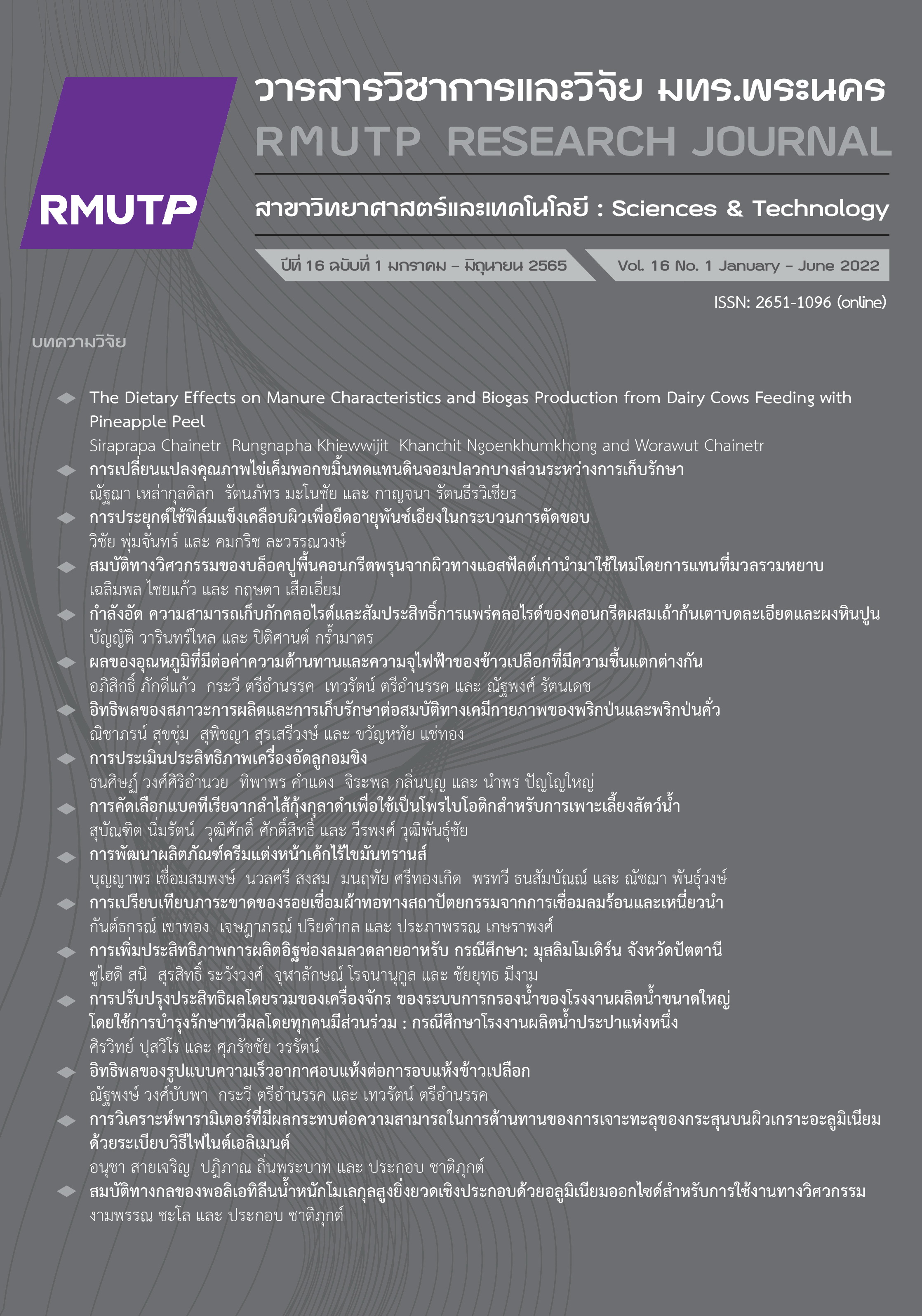Compressive Strength, Chloride Binding Capacity and Chloride Diffusion Coefficient of Concrete Containing Ground Bottom Ash and Limestone Powder
Main Article Content
Abstract
This research was aimed to study the compressive strength, chloride binding capacity and chloride diffusion coefficient of concrete replaced by ground bottom ash (GBA), and limestone powder in ordinary Portland cement (OPC). The water to binder ratios were 0.55. The results showed that the compressive strength of concrete with GBA was lesser than that of OPC concrete at 28 days. Also, the compressive strength of concrete with limestone powder was close to that of OPC concrete and compressive strength could develop of concrete with GBA 20% and 30% higher than that of OPC concrete at 56 days. Moreover, the total chloride of the concrete containing GBA and limestone powder was less than that of OPC concrete. The chloride penetration of the concrete containing GBA and limestone powder was less than that of OPC concrete. The chloride binding capacity of the concrete made with ground bottom ash and limestone powder were higher than that of OPC concrete. Finally, the chloride diffusion coefficient of the concrete containing GBA and limestone powder was less than that of OPC concrete.
Article Details

This work is licensed under a Creative Commons Attribution-NonCommercial-NoDerivatives 4.0 International License.
ลิขสิทธ์ ของมหาวิทยาลัยเทคโนโลยีราชมงคลพระนครReferences
C. Jaturapitakkul and R. Cheerarot, “Development of Bottom Ash as Pozzolanic Material,” Journal of Materials in Civil Engineering, vol. 13, no. 1, pp. 48-53, Feb. 2003.
R. Cheerarot and C. Jaturapitakkul, “Use of Ground Bottom Ash as a Pozzolanic Material in Concrete,” Research and development journal, vol. 14, no. 2, pp. 1-8, 2003.
K. Tuntisukrarom, T. Choksawangnetr, P. Srihabutra and R. Cheerarot, “Utilization of ground bottom ash in high performance concrete,” Research and development journal, vol. 23, no. 1, pp. 40-47, 2012.
S. Inthata and R. Cheerarot, “The Resistance to Chloride Penetration of Ground Bottom Ash Concrete,” Research and development journal, vol. 19, no. 2, pp. 39-46, 2008.
P. Krammart and S. Tangtermsirikul, “Sulfate Resistance of Mortars with Limestone Powder,”in Proceeding of the 3rd Annual Concrete Conference, Thailand Concrete Association, October 2010, pp. MAT 89-96.
H. Hornain, J. Marchand, V. Duhot and M. Moranville, “Diffusion of chloride ions in limestone filler blended cement pastes and motars,” Cement and concrete research, vol. 25, no. 8, pp. 1667-1678, Dec. 1995.
S. Arttamart and T. Sumranwanich, “Compressive strength and chloride penetration resistance of concrete with fly ash, limestone powder and partial replacement of fine aggregate by bottom ash,” Journal of Engineering, RMUTT, vol. 17, no. 2, pp. 113-125, 2019.
T. Jena and K.C. Panda, “Mechanical and durability properties of marine concrete using fly ash and silpozz,” Advances in Concrete Construction, vol. 6, no. 1, pp. 47-68, Feb. 2018.
American Society for Testing and Materials, ASTM C 204 - 00: Standard Test Method for Fineness of Hydraulic Cement by Air-Permeability Apparatus, Annual Book of ASTM Standards, 2000.
American Society for Testing and Materials, ASTM C 188 - 95: Standard Test Method for Density of Hydraulic Cement, Annual Book of ASTM Standards, 1995.
British Standard Institute, BS 1881: Part 108 Method of Making Test Cube from Fresh Concrete, London, 1983.
American Society for Testing and Materials, ASTM C1556, Standard test method for determining the apparent chloride diffusion coefficient of cementitious mixtures by bulk diffusion. 2004. vol. 4.02.
American Society for Testing and Materials, ASTM C1152, Standard test method for acid-soluble chloride in mortar and concrete. 2004. vol. 4.02.
American Society for Testing and Materials, ASTM C1218 M-99R08, Standard test method for water soluble chloride in mortar and concrete. 2008. vol. 4.02.
S. Tangtermsirikul, Durability and Mix Design of Concrete, 1st ed., Printing House of Thammasat University, 2003.


